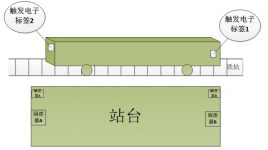
Shanghai Metro Line 2 Management RFID Solution
[ad_1]
I. Overview
This solution adopts Automatic Incident Detection (AID) technology based on Radio Frequency Identification (RFID), which can realize event tracking and identification, and weather factors have little influence on the identification effect, which is suitable for outdoor occasions. Active RFID technology uses electromagnetic wave propagation to realize the identification of items, and electronic tags are used as information carriers to be attached to the identified objects. Its advantages are:
1) The reader on the platform communicates with the on-board electronic tag wirelessly, which can accurately obtain the relevant information of the train.
2) It has the ability to distinguish the train and its track, which can effectively improve the accuracy of event detection and recognition, and reduce the rate of false alarms.
3) Readers and electronic tags use microwave frequency band communication, which is less affected by bad weather such as rain, snow, and fog, and can work around the clock.
4) There is no need to close the track for installation and maintenance, and it has no effect on the service life of the track.
5) It can judge the running direction of the train by itself, and upload the train’s entry and exit time and track information, which is convenient for follow-up traceability.
6) Know the location and status of trains on the line at any time, and make better management and temporary deployment to maximize the use of subway resources.
2. Overall solution
Scheme design process

As shown in the figure, the trigger electronic tag is placed in the middle of the front and rear of the vehicle, and they are given different numbers for easy distinction (such as trigger electronic label No. 1 and trigger electronic label No. 2); the triggers are installed on the platform respectively On both sides, give them different numbers for easy distinction (such as trigger A, trigger B). The trigger uses an external antenna. The antenna is arranged in a door frame shape and can be installed on the screen door of the subway platform (depending on the actual situation). It depends); the reader is installed on the platform, and the range can cover the trigger.
1) Train direction
Stop at the platform and drive past
As shown in the figure, the trigger electronic tag 1 is first read by reader A, and then the trigger tag 2 is read by reader A. When the trigger tag 1 is read by reader B, it can be judged. The direction is to drive to the right and have pitted. Finally, when reader B receives the trigger electronic tag 2, it can determine that the train has left the platform. From the time difference between the trigger tag 2 received by readers A and B, it is judged whether the train stops on the platform.
After entering the station, run in the opposite direction
Under the premise that the train has entered the station, the trigger electronic tag 2 is not read by the reader B, but the trigger electronic tag 1 is read by the reader A again, it can be judged that the train runs in the opposite direction after entering the station.
2) The track where the train is located
Because the trigger range is adjustable from 1 meter to 3 meters, even when installed on a side platform, there will be no mutual interference or misreading. Therefore, in the case of side platforms, number the triggers of the two platforms separately to distinguish the track on which the train is located.
3) Train in and out time
When the reader on the platform reads the trigger tag for the first time, it will determine the front of the train. (As shown in the figure, set trigger tag 1 as the front of the train) when there is trigger tag 1 read by reader A first , When it is read by reader B, the system records the time, which is the time when the train enters the station.
When reader A first reads trigger tag 1 and then trigger tag 2, when the trigger tag 2 is read by reader B after a period of time, the system records the time, which is the time when the train leaves the station.
Third, the program involves a list of hardware
Product classification specification model description
Chaowei long-distance trigger reader ZWT-RFR6L00 judges the installation position according to the situation of the station
Chaowei trigger ZWT-LFJ01 external antenna
Chaowei trigger active electronic label ZWT-TGW6C01 RF signal is stable
See instructions for details
External antenna, the antenna is placed on both ends of the platform (on the subway platform) in a door frame, the trigger distance is about two meters, the shape of the antenna is rectangular 1.5*3 (height*length) (m) (depending on the actual situation)
[ad_2]



